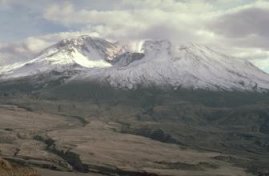
October Editorial
Mount St Helens

October Editorial
Mount St Helens
|
|
Mount St Helens, in Washington state, USA, has been in the news again. In the past two months or so the dome-shaped formation of rock in the crater has been developing a large bulge, and frequent plumes of gas have been seen rising from the crater. These are clear signs of volcanic activity and they are very similar to what was seen before the eruptions of 1980. Latest reports tell of a steam plume rising passively and drifting south and south-westward over the crater rim. The plume occasionally contains minor ash, which falls in the crater and on the southern flank of the volcano, darkening the new snow. Seismic activity remains low compared to that observed earlier, and is consistent with a slow but continuous rise of magma driving up the crater floor and feeding a surface extrusion of lava. The overall low rates of seismicity and gas emission suggest that the lava reaching the surface does not contain much gas. This is good news, since it means that highly explosive eruptions are less likely in the near future. For an up-to-date report on volcanic activity at St Helens point your browser to current-conditions. There is also a webcam feed from the mountain itself at www.fs.fed.us/gpnf/volcanocams/msh/images/mshvolcanocam.jpg. Background. Mount St Helens is an active volcano which resides in the The Gifford Pinchot National Forest, located in southwest Washington State. In 1980 there was a catastrophic explosion of the volcano which consisted of six explosive magmatic eruptions - May 18, May 25, June 12, July 22, August 7 and October 17, 1980. The present lava dome at Mount St. Helens is the third dome to form since the 1980 eruption, the first two having been blasted away by subsequent eruptions. Rock. Since the late 1980s and early 1990s, volcanic lava from Mt St Helens has been extensively studied. A large number of samples have been collected and analysed for their chemical composition. From this a generalised prediction of mineral content has been prepared which is shown in the table below.
Interestingly, studies of Mt St Helens also offer a unique opportunity to test the accuracy of radioisotope dating. There are two reasons for doing this: firstly radioisotope dating methods are mainly used on volcanic (igneous) rock since fossil-bearing sedimentary rock cannot be directly dated radioisotopically. Secondly, this was one of the rare occasions when the exact age of the lava being analysed was known. Radioisotope dating is widely perceived to be the "gold standard" for dating rock and the results are considered "proof" that earth's history goes back for millions of years. To test the accuracy of radioisotope dating, scientists collected the samples from Mt St Helens and sent them to a laboratory for checking. They did not say where the rocks were taken from. What came back from the lab was not only surprising, but also alarming. The summary of the results is shown in the table below:
So a ten-year-old rock was estimated as 300 000 years old! How could this have come about? The mistake, it seems, was in the generally-believed theory that the radioisotope clock is set at zero in molten rock and starts ticking when the igneous rock solidifies. However, the laboratory tests show that the lava of Mount St Helens was already 40Ar reach. Is it time to re-think the theory? |
| _______________________________ | ||||
| Home | | | Shopping | | | Database |
© Biscuit Software 2004-2015
All rights reserved